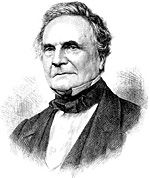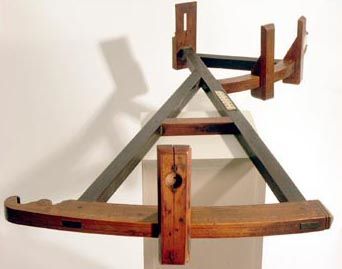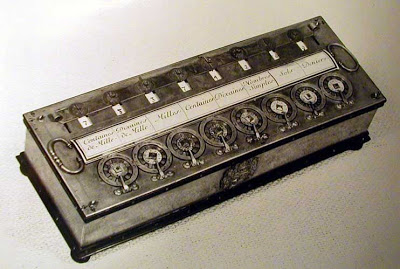Babbage analytical machine. Part one - who is Babbage and why do we need counting machines?

Charles Babbage's analytical machine is considered the first prototype of a modern computer. This machine is actually a century ahead of progress. But like many colossi that were ahead of their time, it was never embodied in metal. Like any great invention, she could not be born from scratch, and her creator could not be an ordinary person. In subsequent posts, I want to tell a little about the biography of this man, what pushed him to the creation of this machine and how the main business of his life ended.
')
Where do geniuses come from
Charles Babbage was born in the family of a banker Benjamin Babbage, December 26, 1791. Due to poor health, Charles did not attend school, but grew up to be a very inquisitive child. Receiving a new toy, he invariably asked the question “Mom, what is inside?” And until he received an answer, he did not give rest to either the toy or others. If the answer did not suit him, the toy was subjected to an autopsy. I think many readers of Habr will recognize in themselves a similar trait - the “old iron” blog does not suffer from a lack of content.
By eleven years old, the parents still decide to send Charles to a private school and place him under the care of a priest who holds a school in the town of Alfington in Devonshire. Benjamin Babbage asked the priest not to give his son strong training loads, so as not to undermine his poor health.
At the end of this school, Charles begins a real training - he is sent to the academy in Enfield, where he becomes acquainted with the textbook, which determined the passion of his whole future life. It was Ward's Guide for Young Mathematicians. He was so carried away by algebra that he entered Cambridge and was surprised to find that he knew much more about her than his tutor.
In 1811, Charles became a student of Trinity College - the most famous college of Cambridge. At that time, such famous personalities as Isaac Barrow and his student Isaac Newton had already left the doors of this educational institution. Closer to our days this college was completed by such personalities as Bertrand Russell, a number of British monarchs and princes (including Prince Charles).

(Trinity College, 1838)
But back to our student. While studying at Cambridge, Charles concluded that Britain was far behind continental Europe in terms of mathematical background. As a result, the Analytical Society was born, which included his friends, John Herschel and George Peacock. At meetings of society, friends discuss the works of continental colleagues, publish "Notes of the Analytical Society."
Charles considered the abilities of his friends to be much higher than his own and in order not to be the third in Trinity College, he goes to St. Peter's College, which he finishes in the first place.
A portrait of an inquisitive, capable, talented and ambitious young man looms before us. This combination of features very few people can afford to live life quietly and calmly. Our hero is no exception. Naturally, he was interested in current and advanced problems of mathematics. One of these problems was the problem of efficient, fast and accurate compilation of various tables - logarithmic, arithmetic, interest tables, etc.
Why the tables?
Background of the advent of computers
It is worth remembering that at the end of the eighteenth - the beginning of the nineteenth century was the peak of the industrial revolution, the leader of which was Britain. The transition from manual labor to industrial scale was accompanied, so to speak, by the rapid growth of other sectors of the economy. Banking and insurance business grew, the volume of sea transportation, construction increased - all this required a large number of calculations - the calculation of compound interest, the calculation of geographical coordinates, engineering calculations, etc. Already in the eighteenth century, navigators actively used various tables.
In 1776, the Maritime Calendar was born (its author is the learned doctor Maskelin, later the royal astronomer). The calendar was a set of astronomical, navigational, and logarithmic tables based on the observations of the astronomer Bradley. Despite the unprecedented hitherto thoroughness, this work had a lot of errors and inaccuracies generated by the low accuracy of the original data, the inaccuracy of calculations and errors in the rewriting.
An interesting case shows the consequences of such errors. After the end of the Anglo-Spanish war in the Mediterranean, the English and Spanish ships met. Freshly baked friends decided to show respect to each other and exchange gifts. Fortunately for the English captain, his Spanish colleague decided to give him only a silver tray. But the Spanish captain was less fortunate - the Englishman presented to him, without any malicious intent, the navigation tables of Thomas Young. The publication was of the highest quality, but the tables were completely wrong, because they did not take into account leap years. Nobody ever saw the Spanish captain who accepted such a gift, but the English captain got to the destination perfectly using French and Italian tables.

(Navigating device of the 18th century. Source )
The “marine calendar” was published annually, publishers had to keep a large staff of proofreaders, but even this did not save them from mistakes.
At the end of the 18th century, an original way of organizing computational labor was proposed, increasing the reliability of computations. Its author was a mathematician Gaspard Claire Francois Marquis de Prony.
The calculations were organized on the "conveyor system" consisting of three groups. The first, the smallest, the most qualified consisted of 5-6 mathematicians. She was engaged in the choice of formulas and drawing up calculation schemes. The second of 7-8 mathematicians determined the values of functions in 5-6 intervals in accordance with the selected formulas. The third, the most numerous, consisted of ninety low-skilled calculators, who were engaged in the compaction of the table, filling in the intervals calculated at the previous stage. Two groups of computers worked in parallel, verifying their results.
Babbage became interested in this scheme and he had the idea to replace the last stage of manual calculations with a mechanical machine that would automate, as he wrote, “the most primitive actions of human intelligence”.

(Blaze Pascal Calculator. 17th century. Source )
Machines capable of performing simple addition, subtraction, and even multiplication operations by that time were not created by the first century by various mathematicians and mechanics, although at that time they were not widely used. Babbage conceived not just "mechanical bills." He had the idea of a specialized computing device, sharpened by the creation of tables, which made it possible to calculate them quickly, efficiently, which required low qualification of personnel, and also (which is important), allowed to fix the results of the calculations made on paper.
For the second decade of the nineteenth century, it was a very bold idea. However, even Babbage himself didn’t guess how far the idea would have been born in his head in 1812.
In the next part I will talk about the creation of Charles Babbage's difference machine and the birth of the idea of creating an Analytical machine.
The main source used in the preparation of the text is “From Abacus to a Computer”, R. S. Guter, Yu. L. Poplunov, Moscow 1981.
The second part of.
The third part.
Source: https://habr.com/ru/post/80334/
All Articles